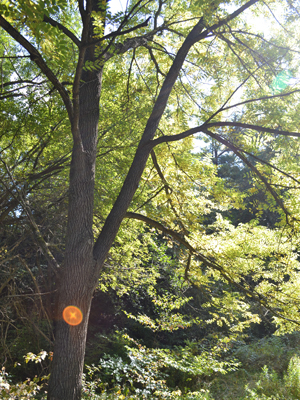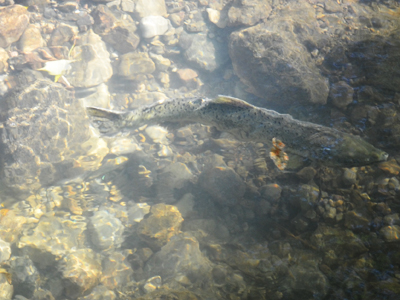My tour co-leaders were Wing Morse, an active volunteer with the Pomona Mills Park Conservationists for over 10 years, and Nory Takata, who has worked extensively with community groups and NGOs on stewardship projects and is currently the Parks Planner for the City of Markham. We were excited we caught such a gorgeous day, and I was happy to be working with two gentlemen so passionate about improving our natural spaces.

The Tour was a celebration of the efforts of the Pomona Mills Park Conservationists. Their goal: restore a more natural habitat for plant and animal life and provide a natural contact with that environment for the community. With their annual plantings and clean-ups, the group has transformed the park from a Kentucky bluegrass lawn to a thriving meadow and biodiverse young forest.

The tour began with a description of the garden that had recently been planted at the west entrance of the park. And for those of you not familiar with the area, take my word – from thickets of thistle to thriving native shrubs and perennials, the difference is astounding. Bees and butterflies now pollinate the red osier dogwood (Cornus sericea) and black eyed-Susans (Rudbekia hirta) that welcome park visitors.
We moved towards the middle of the park to a section that was at destined to be a condo before community intervention saw it preserved as parkland. The Pomona Mills Park Conservationists have since worked diligently to convert the area. It is now a stunning example of biodiversity that houses ground nesting birds and provides habitat for countless other fauna. While the rest of the park sits in a valley, this is the only area that is considered upland, and is therefore a perfect site for meadow plant species. With all of its asters (Aster spp), serviceberries (Amelanchier spp) and fragrant sumacs (Rhus aromatica), the meadow teems with colour and life.

As we walked along the path, we learned that stewardship projects can come with their own frustrations and challenges. Wing described how a grove of staghorn sumac (Rhus typhina) was encroaching on a number of black walnut (Juglans nigra) trees and the decision to cut back the sumac in favour of the walnuts was a tough one. Staghorn sumacs are a native and desirable species; however, if left to its own devices, the grove would outcompete most other species, creating a monoculture. It was a good opportunity to discuss if and how humans should intervene – a question that permeates through all stewardship efforts.

Another challenge the stewardship group faced was that their hard work sometimes felt like it was done in vain. Upon returning to specific planting sites, it was noticed that invasive species once again took over the area and many plants didn't survive. Many hours of hard work and much valuable plant material seemed to be wasted. The culprit was lack of maintenance including watering, weeding and mulching. It was a difficult lesson to learn, but from that moment onward the Conservationists added much needed (and often overlooked) site maintenance to their mandate.
We watched a demonstration of staking red osier dogwood for the purpose of riverbank stabilization. We visited a dying ash (Fraxinus spp) tree and learned about the devastating effects of Emerald Ash Borer (EAB) on our urban forest. But one of the greatest tour highlights was something we couldn’t have planned - watching salmon spawning on the river!

One of the goals of the Pomona Mills Park Conservationists was to increase the tree canopy along the riparian zones in the park. Fourteen years after their first annual planting, the park’s riverbank has a complete canopy. This provides much needed erosion control, since tree roots stabilize the bank and canopy slows down rainfall. Another of their objectives was to bring community together, and in this area they have also succeeded. Over the years, Wing has noticed an increased interest in the stewardship efforts among park visitors. People have been brought together by the presence of a small group of dedicated and passionate individuals. And together we can marvel at the transformation – a truly thriving ecosystem.
Join us for one of our upcoming Tree Tours this fall! Our Tree Tours are supported by Ontario Power Generation's Biodiversity Program, York Region and the Ontario Trillium Foundation.
